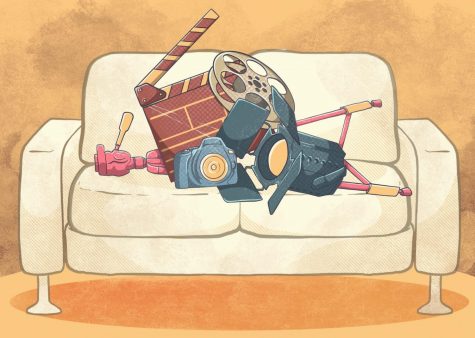Lack of facilities hinders success of online photography courses, students and faculty say
This article is part of the Chronicle’s series “Difficult to Transfer” in which we explore how departments are transitioning arts-based courses online due to the coronavirus, or COVID-19, pandemic.

To complete assignments for her “Experimental Photography/Graphics Techniques I” course, Nyia Sissac has crafted a makeshift darkroom in her parents’ laundry room. Even with clothes now tangled with stacks of photo paper, it has become a safe space for her to create.
To develop self-portraits, the sophomore photography major makes do with the minimal supplies she has—a cyanotype kit mailed to her from Chicago by the Photography Department and tap water.
“It’s really difficult trying to create something out of nothing,” she said. “I’m having fun with it at some points, but at other times it’s not like I can turn around [to] my teacher right behind me and ask a question.”
The Photography Department announced in a March 14 email to photography students that departmental courses would be online for the remainder of the semester due to the coronavirus, or COVID-19. And at about the same time the official word of the college’s suspension of all in-person instruction spread throughout the campus.
Since then, the department has struggled moving forward in teaching photography classes without facilities available, such as the darkroom, the Photography Lighting Studio and specialized printers, although Ross Sawyers, chair of the Photography Department, said no classes have been canceled in the online transition.
“Our facilities are such a critical part of what we do,” Sawyers said. “It’s a priority for me to figure out if there’s any way that as a department we can … make up for some of the lost access to facilities.”
As reported by the Chronicle, students in certain photography courses were allowed to check out specialized equipment kits to complete coursework remotely.
To boost engagement, the department has been hosting a “Show and Tell Stay Well” video series on Instagram that lets faculty show off their favorite photo books. Sawyers also holds a weekly Zoom conference for students to discuss any concerns.
Sawyers said in-class experiences are hard to replicate in an online setting because there is no substitute for hands-on work in these facilities. Providing meaningful experiences outside the classroom has been the department’s biggest challenge, he said.
Paul D’Amato, a professor in the Photography Department, said transitioning online has halted the production of a final project for one of his courses, “The Documentary Book,” leaving it “dead in its tracks.”
The objective of the course was initially for each student to create a handmade book of their documentary photographs, but D’Amato said remote classes and statewide stay-at-home orders have made the hands-on experience nearly impossible.
D’Amato has shifted the course to make the new final project a collaborative documentary book called “Postcards from the Pandemic.” It will feature students’ photographs documenting their own experiences through the crisis.
Christopher Schneberger, a part-time faculty member in the Photography Department, teaches “Photographic Practice III,” where a majority of the work is done through Adobe Photoshop.
He said it was easy to make a digital photography class remote, but technology issues have still affected his class. Students who were given Chromebooks by the college to complete online work have been unable to download Adobe Suite software needed for the course, he said, adding that he’s working with these students to find alternatives.
Not every course has had a rocky transition, though.
Colleen Plumb, a part-time faculty member in the Photography Department, said her “Video for Photographers” and “Still/Moving: Photography” courses allowed for a fairly seamless transition.
“For somebody who’s [studying] digital photography, it’s about ideas, anyway,” Plumb said. “So, we are able to convey that through digital means and thinking creatively.”
And some students have complimented the faculty’s efforts to make sure students are receiving the attention they need.
Yudi Xia, a first-year graduate student in the photography program, said she appreciates communication and support from faculty, many of whom she said have set up group chats and extra office hours to make up for the lost in-person time.
Yet, despite the efforts of instructors in the department, some students feel shortchanged by the lack of facility access and downtrodden by the creative limitations.
Natasha Moustache, a first-year graduate student in the photography program, said they are not happy paying full tuition when they are unable to access facilities included in the tuition price tag.
“Not getting [access], that’s probably the most frustrating thing for me,” Moustache said.
Moustache said they want compensation for the loss of resources but, as reported April 14 by the Chronicle, the college has no plans to issue tuition reimbursements.
As repayment, Moustache said they hope the college will extend access to campus facilities for students beyond graduation so they can get their money’s worth.
At the same time, Moustache said the pandemic has severely stifled their creative side. Their work used to consist of street photography and portraits—interactions now discouraged under social distancing guidelines.
“Making any kind of work for me has been difficult,” Moustache said. “It’s been impossible to continue in the way that I was making work before.”

